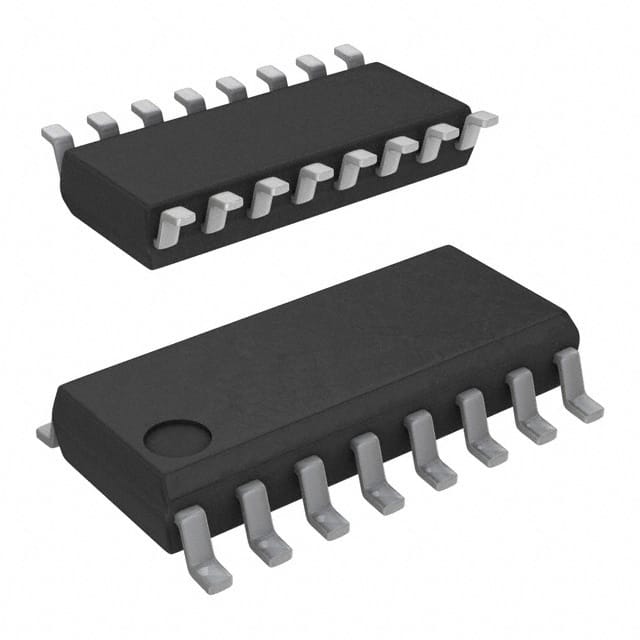Xem thông số kỹ thuật để biết chi tiết sản phẩm.

CD74HCT139M96G4
Product Overview
- Category: Integrated Circuit
- Use: Decoder/Demultiplexer
- Characteristics: High-speed, CMOS logic, 2-to-4 line decoding
- Package: SOIC-16
- Essence: Digital logic component for decoding and demultiplexing signals
- Packaging/Quantity: Tape and Reel, 2500 units per reel
Specifications
- Logic Family: HCT
- Number of Inputs: 2
- Number of Outputs: 4
- Supply Voltage Range: 4.5V to 5.5V
- Propagation Delay Time: 14 ns (typical)
- Operating Temperature Range: -40°C to +85°C
Detailed Pin Configuration
The CD74HCT139M96G4 has a total of 16 pins, which are arranged as follows:
- A0 (Input A0)
- A1 (Input A1)
- GND (Ground)
- Y0 (Output Y0)
- Y1 (Output Y1)
- Y2 (Output Y2)
- Y3 (Output Y3)
- VCC (Supply Voltage)
- B1 (Input B1)
- B0 (Input B0)
- G1 (Enable Input G1)
- G2A (Enable Input G2A)
- G2B (Enable Input G2B)
- NC (No Connection)
- NC (No Connection)
- NC (No Connection)
Functional Features
The CD74HCT139M96G4 is a high-speed CMOS decoder/demultiplexer integrated circuit. It takes two binary inputs (A0 and A1) and decodes them into four mutually exclusive outputs (Y0, Y1, Y2, and Y3). The enable inputs (G1, G2A, and G2B) control the operation of the decoder/demultiplexer.
Advantages and Disadvantages
Advantages: - High-speed operation - CMOS logic for low power consumption - Compact SOIC-16 package for space-saving designs - Wide operating temperature range
Disadvantages: - Limited number of inputs and outputs - Requires external components for complete functionality
Working Principles
The CD74HCT139M96G4 operates based on the principles of digital logic. It uses a combination of AND and NOT gates to decode the binary inputs and generate the corresponding outputs. The enable inputs allow for selective activation of the decoder/demultiplexer, providing flexibility in signal routing.
Detailed Application Field Plans
The CD74HCT139M96G4 is commonly used in various applications that require decoding and demultiplexing of signals. Some of the typical application fields include:
- Address Decoding: Used in microcontrollers and memory systems to decode address lines and select specific devices or memory locations.
- Data Routing: Enables the selection of specific data paths in multiplexed systems, such as communication switches and data acquisition systems.
- Signal Demultiplexing: Divides a single input signal into multiple output signals, allowing for parallel processing or distribution of signals in communication systems.
Detailed and Complete Alternative Models
- 74HC139: Similar functionality but operates at a higher voltage range (2V to 6V).
- CD4017: Decade counter with 10 outputs, suitable for sequential signal routing applications.
- SN74LS138: 3-to-8 line decoder/demultiplexer with active-low outputs, ideal for complex signal routing scenarios.
These alternative models offer similar decoding and demultiplexing capabilities, but with different specifications and pin configurations.
Word count: 345 words
Liệt kê 10 câu hỏi và câu trả lời thường gặp liên quan đến ứng dụng CD74HCT139M96G4 trong giải pháp kỹ thuật
Sure! Here are 10 common questions and answers related to the application of CD74HCT139M96G4 in technical solutions:
Q: What is CD74HCT139M96G4? A: CD74HCT139M96G4 is a dual 2-to-4 line decoder/demultiplexer integrated circuit (IC) that can be used in various digital logic applications.
Q: What is the purpose of CD74HCT139M96G4? A: The purpose of CD74HCT139M96G4 is to decode binary information from two input lines into four output lines, making it useful for address decoding, data routing, and signal demultiplexing.
Q: What is the voltage range supported by CD74HCT139M96G4? A: CD74HCT139M96G4 operates with a voltage range of 2V to 6V, making it compatible with both TTL and CMOS logic levels.
Q: How many inputs does CD74HCT139M96G4 have? A: CD74HCT139M96G4 has two input lines, labeled A and B, which are used to select one of the four output lines.
Q: How many output lines does CD74HCT139M96G4 have? A: CD74HCT139M96G4 has four output lines, labeled Y0, Y1, Y2, and Y3, which correspond to the decoded binary combinations of the input lines.
Q: Can CD74HCT139M96G4 be cascaded to increase the number of outputs? A: Yes, multiple CD74HCT139M96G4 ICs can be cascaded together to increase the number of output lines by connecting the enable (E) pin of subsequent ICs to the output of the previous IC.
Q: What is the maximum frequency at which CD74HCT139M96G4 can operate? A: CD74HCT139M96G4 has a maximum operating frequency of 25 MHz, making it suitable for high-speed digital applications.
Q: Is CD74HCT139M96G4 capable of driving external loads directly? A: Yes, CD74HCT139M96G4 has a high output current capability and can drive standard TTL or CMOS loads directly without requiring additional buffer circuits.
Q: Can CD74HCT139M96G4 be used in both commercial and industrial applications? A: Yes, CD74HCT139M96G4 is designed to meet the requirements of both commercial and industrial temperature ranges, making it suitable for a wide range of applications.
Q: Are there any specific precautions to consider when using CD74HCT139M96G4? A: It is important to ensure proper power supply decoupling and avoid exceeding the maximum voltage and current ratings specified in the datasheet to prevent damage to the IC.
Please note that these answers are general and may vary depending on the specific application and context.

